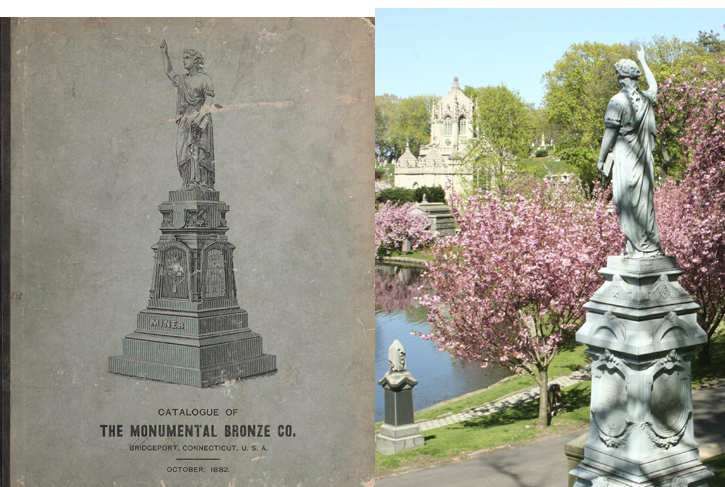This Catalogue of the Monumental Bronze Co. is one of the many examples of trade literature that the Cooper-Hewitt National Design Library has in its collection; they are among the most valuable research resources for documenting the tastes and trends of culture, and the products being marketed and sold in a given time period. This is a salesman’s tool. These are Victorian era zinc sculpture and ornaments for cemetery grave markers and “monuments”. “White bronze” was an attractive, elegant trade name for zinc. It actually has a bluish gray color, and the catalog asserts that this material “is more pleasing to the eye in the form of Statues and monuments than is the dark of Antique”. It is easy to spot the unmistakable color from quite a distance amongst the more traditional and widely used traditional marble, limestone and granite memorials. White bronze is found in large numbers on the East Coast; New York City metro area cemeteries are dotted with them, though they were sold everywhere. The catalog provided the consumer an opportunity to create personalized monuments with elements and forms that best expressed both one’s aesthetic tastes and personal preferences. You could select what you wanted in a memorial and customize the design much the way you furnish a room or build a house.

Left: White bronze monument with Sheaf of Wheat emblem. R: Assorted emblems available in Monumental Bronze catalogue. p.7
In the 19th century, grave markers, could be ordered from companies that worked directly with stone quarries, or from companies like Monumental Bronze. Gravestones are much the same today; they are known as “blanks”, which could be customized in many ways; names, dates, epitaphs, and designs were cut or carved, or applied depending on the customer. Religious, fraternal and popular Victorian iconography was important additions on some gravestones, as personal expression is today. Designs with particular flowers, leaves, or other objects often characterized the personality of the deceased, or the hopes of those left behind. These could be “read” at a glance, they were part of the popular and material culture of the day. For example, a sheaf of wheat symbolizes a long and fruitful life and symbolizes immortality as part of the harvest cycle. “Rock of Ages” is the title of a hymn popular in the 19th century and still is today. Monumental Bronze offered many iconographical emblems or statues that could be, combined, mixed and matched and added to a large selection of “blank” bases; pedestals, obelisks, columns, to create a memorial.

Left: “Rock of Ages”, or “To the Cross I cling” emblem in catalogue (detail). R: White bronze cemetery marker with “Rock of Ages”.
White bronze “stones” were placed in cemeteries all over America from the mid 1870’s to World War I. Markers weren’t advertised or erected after 1914 because the Bridgeport, CT plant was taken over by the U.S. government for manufacturing of gun mounts and ammunition. Fashions changed after the war and the demand for white bronze monuments ended. The Monumental Bronze plant closed in 1939.
Elizabeth Broman is a Reference Librarian at the Cooper Hewitt, Smithsonian Design Library.

9 thoughts on “White Bronze- Designing for Death”
Karen on March 2, 2019 at 4:17 pm
I have a book called Corinthian. Frosted Zinc or White Bronze Monuments by Wilson, Schuyler, & Co., Sole Manufacturers, B’Port, CT. It has pictures of all types of monuments and looks very old. Is there any interest in this book ?
Brice on March 11, 2019 at 9:36 pm
Hi. I’m doing a tombstone project and would very much like to see this book. Is it for sale? Thank you.
Rand on April 15, 2019 at 12:53 pm
I would be interested in the book as well
Jeff on February 12, 2022 at 10:43 am
I would be very interested in this book. This is the the company that began The Whites Bronze monuments before changing ownership and names
Jane on September 12, 2019 at 2:30 pm
If it’s not too late, I would be interested in seeing or possibly purchasing the book as well.
David Marchetti on October 11, 2019 at 3:27 am
Does anyone still make them that you know of? Wife and I are discussing our final plans…
J VanHolstyn on May 11, 2020 at 11:09 am
My 2nd great grandmother has a white bronze tombstone. She died in 1885 in Chatfield, Ohio. It is in beautiful condition 135 years later.
Michelle J Lindemann on October 23, 2020 at 5:22 pm
My grandfather was a salesman for Monumental Bronze Company in the early 1900’s near Eldon, Missouri. One of the booklets says that the “white bronze” monument was introduced at the 1904 World’s Fair. He gave me his salesman book with purchase papers, booklets and cards several years ago. I don’t think my children will be interested in inheriting it. Can someone tell me what it is worth and what I should do with it?
Casey on April 21, 2021 at 6:46 pm
I would love to be able to see what you have with the possibility of buying it! If you still have it and are interested in selling please email me at cdmartin101@gmail.com